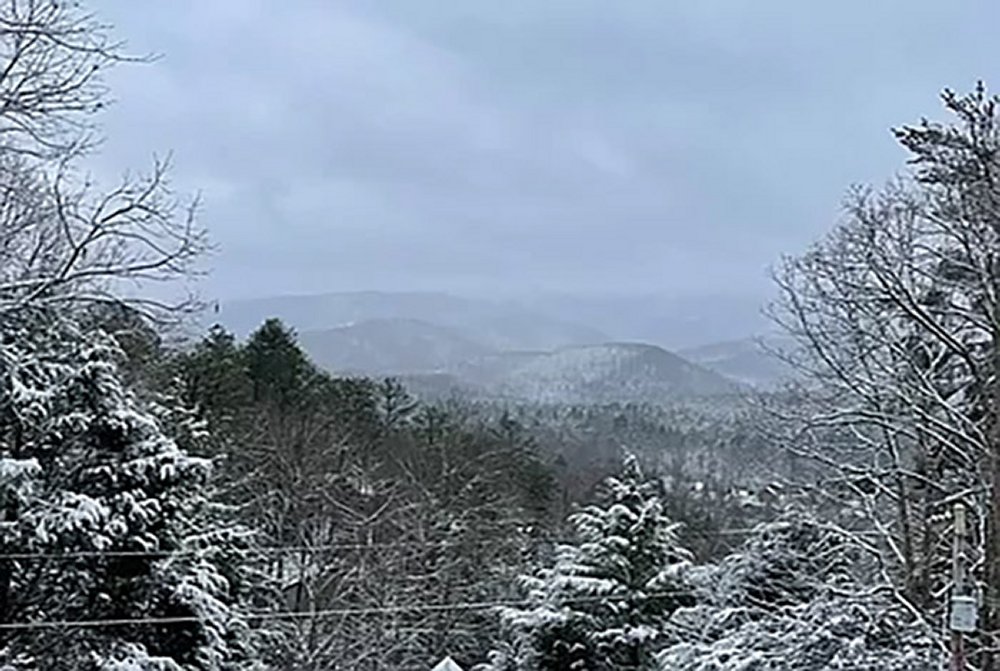Here are some suggested trails for winter hiking in Great Smoky Mountains National Park. This offers snow and ice in comparatively mild temperatures with accessible trails ranging from dead easy to challenging, and great scenery to traverse through, with visibility enhanced from the lack of leaves on most of the trees. The park is open all year with no admission fee.

While the summer crowds are gone, there are still people about in winter, many with the same idea of hiking the trails – and especially visiting the waterfalls in hopes of seeing one frozen. As always, start early in the day for the quietest time, and in winter allow extra time for round trips and remember daylight is shorter.
Take the usual precautions and preparations for winter hiking conditions: print a map and take a compass, take an energy snack and water, wear layers and have spare (dry) socks. Trekking poles are a good idea at any time of year, and crampons or cleats are a great investment for winter conditions in the park. Check the weather and any closures before you go – some trails may close literally overnight from temporary conditions – and let someone know your itinerary and timetable.
Winter Trails
For some of the easiest ways to get outside in nature, check out our guide to Easy Outdoor Adventures. Much of the advice there will apply to winter, but of course always check ahead for seasonal closures (such as the Roaring Fork Motor Trail). The Nature Trails are especially worth checking out in winter.
Metcalf Bottoms Trail
For an easy and family-friendly hike, consider Metcalf Bottoms. A cool oasis in summer, the short and level trail (1.5 miles each way) makes a nice excursion in winter, with a picnic area to recover afterwards.
Laurel Falls
Laurel Falls is low elevation, with a short and easy trail to approach a very popular waterfall. If the waterfall is partly frozen when you see it, you’ll remember it for the rest of your life, so you can see why lots of people go there, but in winter the crowds are greatly thinned.
Do remember that when we say “easy”, you still need good footwear and to be careful, because a sprained ankle (or worse) will ruin your visit, and you can pick such a sprain up “easy” on any of the rocky and tree-root covered trails in the park.
Cades Cove
This is the most popular destination in the park, so you’ll see people at any time of year. It’s lower elevation so conditions may range from easy to muddy. If you’re in this area in winter, try the Nature Trail for an easy walk with the family. In winter, the only way into Cades Cove is via Laurel Creek Road, and if you travel this way, consider a detour along Schoolhouse Gap Trail – check a map to see where the trailhead begins.
Schoolhouse Gap Trail
This is an old roadbed with a gentle slope. It can get slippery coming back, and it’s 4.1 miles each way. This trail is great for spring wildflowers, and there are no stunning views but it’s a nice walk in the woods. This is bear country but that’s not a problem in winter. This is also a horse trail so keep your eyes on where you walk. A peaceful walk.
This is in the Tremont Area (and in any time of year you should know about the Special Areas of the National Park), and if you’ve approached Cades Cove or Schoolhouse Gap, you’re in the vicinity of Indian Flats Falls, which is beautiful and usually accessible in winter if you’re a bit of a hiker. If you’re really a hiker, and have good ice traction on your boots, you may want to consider Spruce Flats Falls also – this can be a slightly dangerous trail in places, with a steep drop-off, so it’s only for careful hikers.
Hen Wallow Falls
This waterfall could easily be frozen over in the dead of winter. Hen Wallow Falls are in a beautiful part of the park, with a relatively short (2.2 miles each way) trail that’s rated moderate in difficulty. If you decide not to take the trail, you’re still in the Cosby area, which offers some lovely attractions for the whole family to enjoy, including the nature trail.
Porters Creek And Fern Branch Falls
Staying in the eastern side of the park, check out Porters Creek Trail which leads to Fern Branch Falls – a great trail with a great waterfall. This is fairly low elevation and should be accessible in winter. This is easy to moderate to hike, but can be rocky and will be wet or icy, so be one of those careful hikers. This trail and falls are in the Greenbrier Area, a location in the park worth knowing about.
Alum Cave Trail
One of the most popular trails in the park, this hike offers fabulous views made even more captivating in winter. The hike is not that long, under five miles round trip, but the elevation gain is significant and it will take a bit of puff to climb. In summer after rain the trail can get slippery in parts, and the drop-off is steep, so be doubly careful in winter. Again, this one is best advised for the more serious hiker, but the views are worth the effort.
Mouse Creek Falls
For a waterfall trail that’s a little off the beaten path, head along I-40 across the park to the border with North Carolina and take Exit 45 to the Big Creek Trailhead. Big Creel Trail is easy and family-friendly, and leads to Mouse Creek Falls. The trail is a little over 2 miles each way, a creekside walk with much to see along the way – including a great swimming hole that you may want to remember for your next mid-summer visit. If the Falls are frozen, get out your camera.
There are many select spots to visit and hike to during winter, and this has been just a small sample. Check out our many guides to Outdoor Activities and Great Smoky Mountains National Park to study the vast range of possibilities, and to start building your own catalog of great winter hikes.





